The
Mistel bomber was one of the more exotic projects of the Luftwaffe during World War II. The Mistel was a large unmanned German bomber flown to a target by a parasite fighter and then released to act as a very large bomb.
 |
| A Mistel combination of a DO-217 and ME-328. |
Unlike a lot other advanced weapons systems, this one worked as advertised, though it did not see enough use to make a difference in the war.
 |
| The Mistel, meaning mistletoe in German, was first introduced in the later years of World War II. The crew compartment in the nose of the unmanned bomber was filled with explosives. A fighter aircraft was attached to the roof and the fighter pilot would fly both planes to the target. The bomber was released and the fighter plane hopefully flew safely home |
First, a word on nomenclature, as this is probably the German weapons system whose real name is mangled more than any other. The Mistel was the bomber underneath the fighter. It was packed with explosives, and usually had a long proboscis to detonate the explosives.
The whole deal, fighter and bomber, is referred to as the Huckepack ("Pick-a-back" in British English, "piggyback" in American English). Other (informal) names were Beethoven-Gerät ("Beethoven Device," named for the attachment equipment between the two aircraft) and Vati und Sohn ("Daddy and Son").
 |
| FW 190 / JU 88 'Mistel.' |
In essence, a manned fighter was joined to an unmanned bomber (preferably obsolete and thus surplus). The fighter flew the bomber to a target and then released it, piloting the pilotless bomber the last way to the target by radio control. Once the bomber exploded on target, the fighter flew back to base.
 |
| Page scan of the Short-Mayo Combo from Modern Mechanix magazine, March 1938. |
The Luftwaffe did not come up with the idea of a parasite aircraft piloting a larger aircraft and then releasing it. That honor goes to the British. The Short Brothers came up with the Short Mayo Composite in the 1930s. This was a piggyback seaplane/flying boat combination designed to provide service across the Atlantic and Pacific Oceans. Short S.21 Maia (G-ADHK) Empire flying boats were used to take Short S.20 Mercury(G-ADHJ) long-range seaplane aloft via a pylon on top of the larger aircraft. Test flights were carried out in 1938 from Ireland to Canada. The smaller aircraft successfully disengaged from the Empire flying boat and completed the journey to Canada while the larger aircraft returned to Ireland. Only one example was built, and it was used to establish various distance records before being destroyed in a Luftwaffe raid on Poole Harbour on 11 May 1941. The idea worked, but it really wasn't commercially feasible due to evolving technologies which made the concept unnecessary.
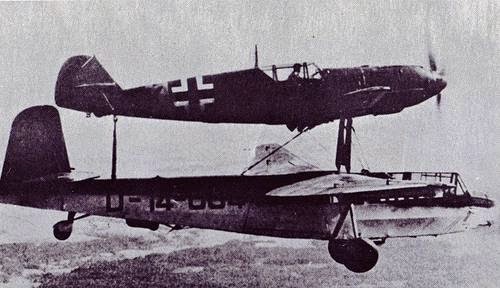 |
| Fritz Stamer testing the Bf-109 E-4 and glider DFS 230 A-1. |
The Germans evidently noticed, however. They decided to reverse the concept by making the lower, larger aircraft the payload carrier which would not return to base. A first test was made in 1942 using a Messerschmitt Bf 109E and an unmanned DFS 230 troop glider. DFS developed the tripod strut supports to mate the two machines. These hooked into plates on the fighters’ wing roots while a single pole supported the fighters’ tails and kept the fuselage axes parallel. In some combinations, the fighter sat at a 15-degree nose-down angle. The set of struts was known as the "Beethoven device" and mounted a single seater fighter plane atop, usually a Me 109 or a Focke Wulf 190. The idea was to give the glider a longer range than if it were simply towed.
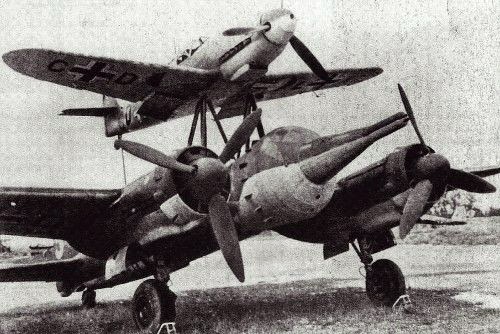 |
| Mistel combination with Me Bf 109 parent aircraft and explosives-laden Ju-88 conversion. Note the proboscis to trigger the explosives in the nose. |
Someone, however, came up with the idea of using a powered bomber for the lower half rather than an engine-less glider. A specialized 1,800 kg (3,960 lb.) warhead was fitted into the nose of the bomber which would use its own engines to help get the combination to the target. The bomber used was usually the Junkers Ju 88, the most produced two-engine aircraft in the Third Reich. Since that bomber was becoming obsolete or at least dangerously vulnerable to fight attacks toward the end of the war - standards rose extremely rapidly from 1939-45 - it was considered expendable.
The fighter-bomber conversion combo was first test-flown in July 1943. Flight testing was finished by October 1943, at which point the warhead was finalized. After further testing and crew training, in early 1944 a bomber unit was tasked with using this deadly combination - II/KG201.
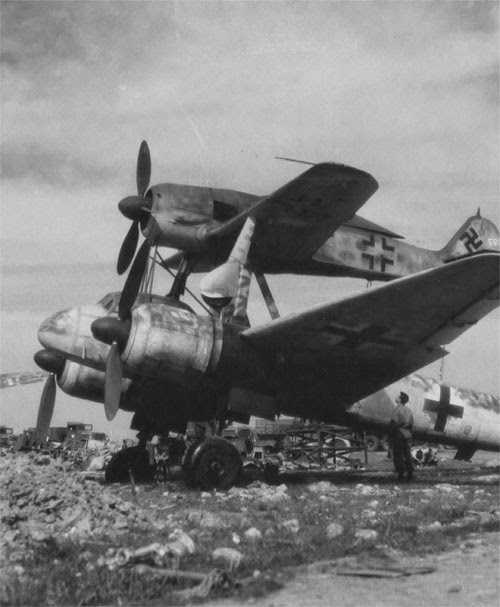 |
| A member of the 439th Troop Carrier looks over a captured German Junkers Piggy Back Plane [Junkers Ju 88 And Focke-Wulf Fw 190] at an air base somewhere in France. 4 May 1945. |
Mistel attacks were made only against shipping targets, with poor results, until November 1944. Then, "Operation Eisenhammer” (Ironhammer) was proposed. This would take place against ground targets in the USSR. However, the attack aircraft were destroyed on the ground and forward airfields overrun, so these never took place.
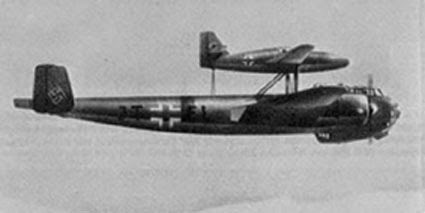 |
| A Do-217E with a Me-328 mounted on it. |
Another idea was to use the Mistel formation against Allied bombers. The bomber would be inserted into the Allied bomber stream and then blown up. This idea was not workable, however, and soon abandoned.

Various plans were made to use jet bombers as the upper control craft as well, such as the Ar-234, He-162, Me-262, Ju-287, and other project jet fighter and bombers carrying a special flying bomb, but these were never realized. A Focke Wulf Ta 154 (the Focke-Wulf Ta 154 Moskito was a fast twin-engined German night fighter) paired with an Fw-190 was also used. A television guidance system was being developed when the war ended.
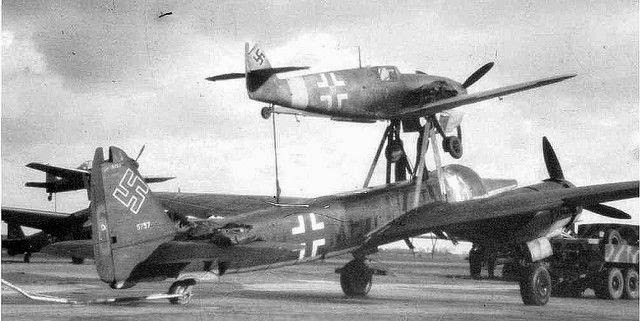 |
| Ju 88 and ME 109 combo. |
Some 250 Mistels were prepared. There were ambitious schemes to use them against Soviet power plants in the Urals, but the combination had a limited range and the front receded too far for this to be practical. Instead, they were used against Allied shipping off Normandy with indifferent results. Some were used as tactical weapons on the Eastern front, to destroy Soviet bridges across the Oder River, but this pretty much failed. The last Mistel attack took place on April 16, 1945, when the Soviet attack across the Oder took place.
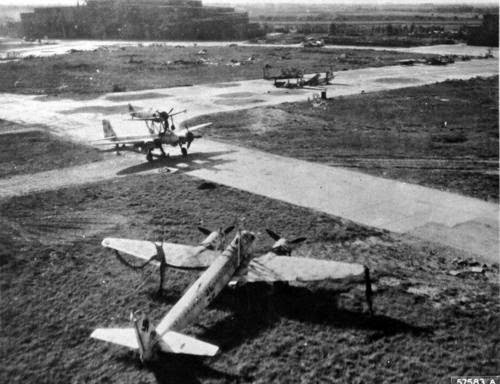 |
| Mistel consisting of a Ju 88 and an FW-190 |
Although many were captured by the Allies, there are no known survivors of the combination. A Focke Wulf 190 that was the upper part is at the Imperial War Museum in London.
Advanced Designs
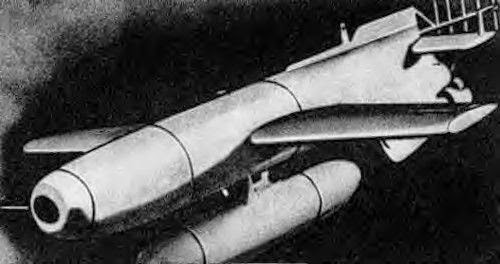 |
| Proposed Hs-293D glide bomb with a television guidance system. |
The Germans, as usual, were better with their designs on paper than they were with actual flyable aircraft. They were designing a glide bomb with a television guidance system when the war ended, television having been invented in New York City in the late 1920s. There were other advanced designs that existed only in theory, as shown in the sketches below.
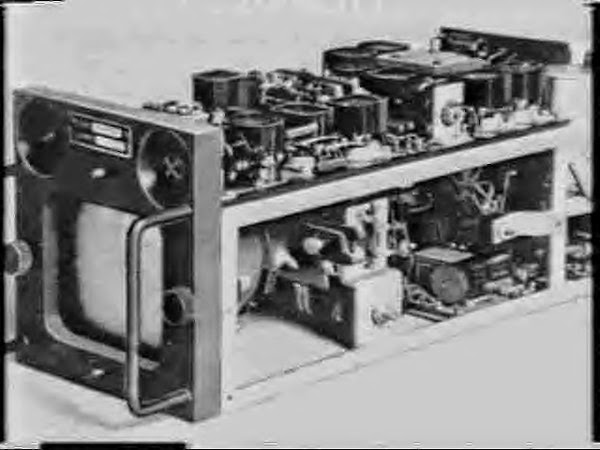 |
| German World War II television guidance system. |
 |
Arado Ar E.377a Mistel (planned).
|
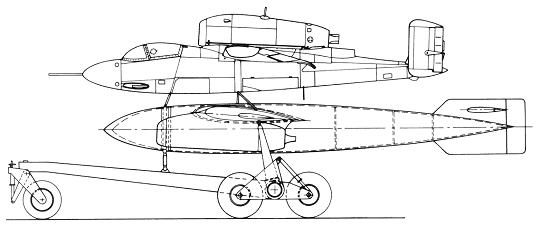 |
| He 162/Ar E.377a Mistel. |
Additional Pictures
 |
| Werner Baumbach (27 December 1916 – 20 October 1953) was a bomber pilot in the German Luftwaffe during World War II. In 1942, he started working on new bomber designs where he helped design the composite bomber system Mistel. In 1944 he commanded the newly formed Kampfgeschwader 200 (KG 200) and was in charge of all Luftwaffe special missions. He received the Knight's Cross of the Iron Cross with Oak Leaves and Swords for the destruction of over 300,000 gross register tons of allied shipping. |
 |
| Lt. Bernard H. Howes of Stoughton, Massachusetts, United States 8th Air Force sights these German Mistel 2's, this variety is comprised of an FW 190 A-8 mounted to a Ju 88 G-1. There were 5 of these sighted over Belgium. This is just before he started firing. He is flying a P-51 Mustang, 3 February 1945. |
 |
| Lt. Bernard H. Howes of Stoughton, Massachusetts, United States 8th Air Force fires on this Mistel 2 (Fw 190 A-8 on a Ju 88 G-1) in Belgium. He is flying a P-51 Mustang, 3 February 1945. |
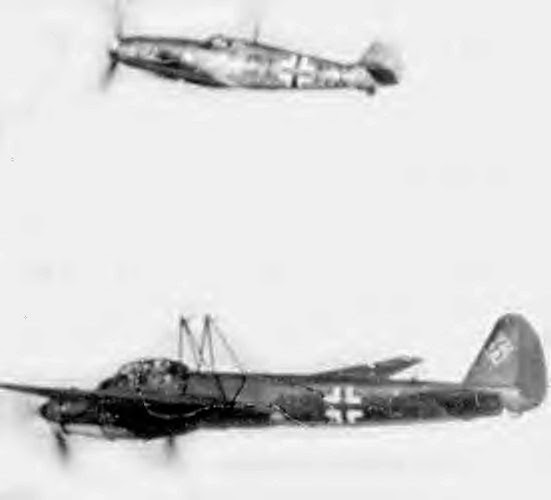 |
| A German "Mistel" Ju-88 bomber & a Me-109 fighter (top). |
 |
| Ju 88 and Fw 190 A "Mistel", Alt Lönnewitz (?), December 1944. |
 |
| A captured fleet of Mistel bombers. |
 |
| A Focke–Wulf Fw 190 / Ju 88 combination known as the Mistel (Mistletoe) in the snow, likeley in Great Britain after the war. Both aircraft wear Royal Air Force roundels as well as a captured Ju 52 in the distance. The bottom Ju 88 bomber would normally have a cockpit area filled with explosives and a long proboscis-like nose that would detonate the warhead. Photo: RAF |
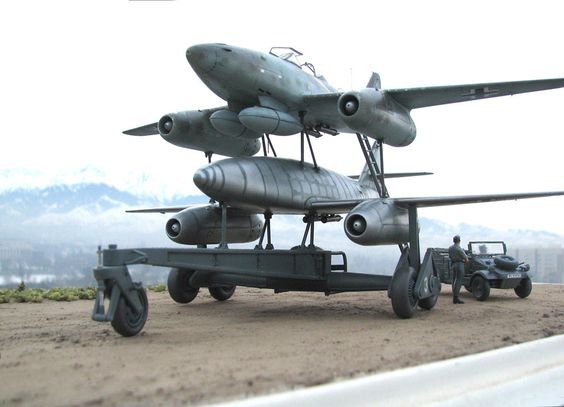 |
| You may see this picture here and there. It is a fake, a very good diorama. The Luftwaffe never got anywhere near actually building something like this, and it would have been a perfectly pointless waste of very precious and scarce Me 262 jet engines. It made much more sense to use large, obsolete medium bombers. |
2019



















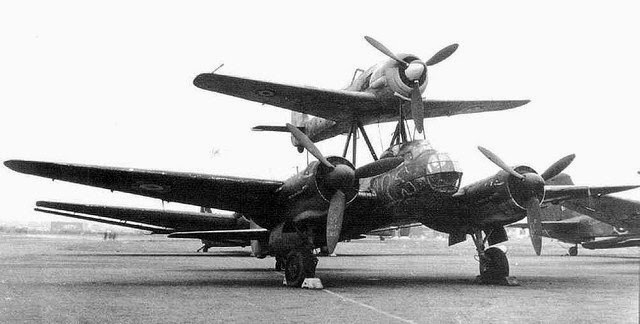








No comments:
Post a Comment